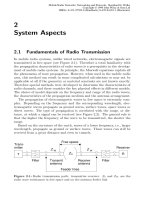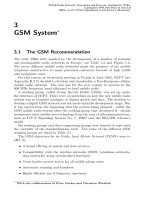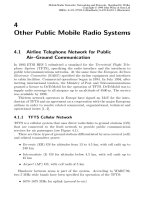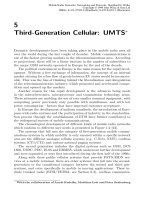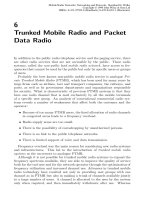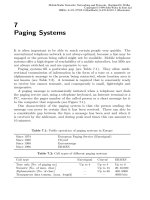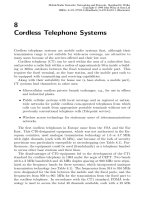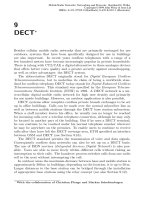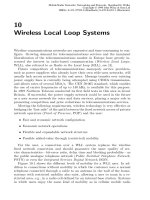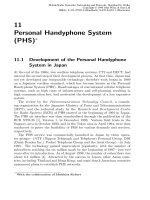Tài liệu Điện thoại di động băng thông rộng không dây P7 ppt
Bạn đang xem bản rút gọn của tài liệu. Xem và tải ngay bản đầy đủ của tài liệu tại đây (1.8 MB, 11 trang )
The necessary equipment is identical with the one from the information services, although
a security layer for achieving authentication, encryption and privacy has to be added to
guarantee safe transactions.
In the future mobile phone (3Gwireless and 4Gmobile), the video screen will get bigger
and bigger while the keypad will disappear. The following functions will be enhanced:
† wireless keypad or keyboard with Bluetooth (or other personal access) technology as an
option;
† information recognition, for example, voice recognition, pattern recognition;
† security detection, for example, fingerprinting sensing;
† bandwidth-on-demand with peer-to-peer direct signalling.
WAP will address the detailed application layer protocol to ensure these functions are
working properly.
In addition, the future mobile applications will address the following issues:
Location and orientation dependent applications and services
Location awareness will play a major role for future wireless services. Currently, there are
many projects working in this field, mostly about virtual tourist guides and similar scenarios.
However, to exploit the full range of possibilities, major issues have yet to be solved.
Micropayment system for content integrated in wireless systems
Mobile content services and electronic commerce are expected to form a large part of value-
added services for future mobile phone systems. There is a great need and potential for
mobile terminals to become ‘electronic wallets’ and media access devices for a large number
of citizens.
A major issue to be solved is payment and charging. Current charging systems for mobile
phones are mainly based on network mechanisms, i.e. connection time, transfer of amount of
messages/blocks/bits, or transaction-based charging. Also, service bundles and monthly
subscription fees are coming in the same manner as in the Internet.
What is missing clearly is service-based charging. For example on-demand-content,
such as MP3 audio, on-demand-movies, mobile games and entertainment are very poten-
tial services. The use patterns for mobile services can be very scattered, so people may
use these services only short times during their travel and empty slots in their daily
work, etc.
Micropayment is defined as a small payment, less than one dollar, which is too small to be
charged immediately, and too big to be ignored. Micropayments are end-to-end visible, like
money, so the receiver and payer can see, understand and trace their comings and goings.
Potentially, large numbers of these payments need to be handled by the network and content
producers, banks and customers. Micropayments are discrete in time, but a stream of micro-
payments can be used to charge continuous streaming type of service. Micropayments can be
positive (charging) or negative (earn by using a service), routed (someone else is paying the
cost, for example, sponsored service). Micropayments can be composite, so they can accu-
mulate costs from lower levels of ingredients, for example a MP3 piece of music can be
charged with micropayments assigning revenue directly to the musicians.
Emerging Wireless Applications and Protocols 259
‘Open Source’ paradigm adoption especially for 3rd party APIs
The open source paradigm means that:
† a cumulating body of source code is available to the developers free of cost;
† a co-ordination function is put into place which tests and accepts the increments to the
body;
† voluntary developers participate to the development of applications based on their own
business, learning or hobby motivations.
During recent years the open source software development paradigm has brought up
surprisingly good results, such as the emergence of the Linux operating system, Apache
server, and GNU compilers. Besides superior quality and innovativeness, this paradigm
has brought a large number of young people into the development of new applications all
over the world, thus heavily contributing to the business process. Besides software develop-
ment, IC and processor core designs have been influenced by this approach recently.
Mobile communications have traditionally been divided into manufacturer/operator
proprietary part, and into public interfaces defined in standards. Typically the proprietary
part is where the differentations of the products and services are performed, giving a compe-
titive edge to the manufacturers or service provider in question.
However, there are new classes of services that are very difficult to specify and implement
by a single manufacturer or operator. For example, mobile games form a quite promising
area where evolutionary development by the users and enthusiasts may create a high volume
of services.
With the rising number of services and the convergence of IP and cellular networks,
automatic service discovery will be a very important feature in future wireless network
scenarios. With service discovery, devices may automatically discover network services
including their properties, and services may advertise their existence in a dynamic way.
WAP will help configure this new feature in the application layer.
In summary, future generation wireless terminals will face significant challenges with
respect to their ability to adapt to all kinds of options. In addition to the WAP improvement,
it is important to continue research in the area of wireless transmission technologies, focusing
on broadband components, signal processing and software definable radio.
4.2.7 WAP System Solutions
The WAP concept provides the operator with a powerful environment to offer the subscribers
value-added services which will boost the usage of data. The concept is realised by introdu-
cing a new type of node in the network, called the WAP Gateway. This node is able to
distribute all WAP traffic to the correct application server. Figure 4.19 shows an overview of
the WAP system framework.
For an example, to provide WAP within the GSM/GPRS infrastructure existing today, the
following additional elements are necessary:
† WAP Gateway – this is an element located at the wireless network operator’s domain
which provides the bridge between wireless networks and the Internet:
–serves as proxy which fetches the requested data from Internet sites;
Broadband Wireless Mobile: 3G and Beyond260
–provides protocol mapping between standard and WAP protocol;
–provides encoding/decoding for efficient transfer of data bearers.
† Mobile Data Application Server – is located at the wireless operator’s site. It runs applica-
tions provided by the mobile operator and serves as an additional source of revenues. This
server is:
–located within secure network operator domain;
–communicates with client via gateway;
–able to ‘push’ WAP contents to WAP client;
–evolution towards Wireless Telephony Application Server (WTA) which is not yet
finally standardised but provides the possibility to initiate a mobile-originated call set-
up directly from the WAP applications.
† WAP Servers – run by external service providers and make the whole world of information
and services of the Internet accessible for subscribers using mobile phones equipped with a
WAP browser.
† Mobile Terminal – WAP clients, have to include a WAP browser in order to support WAP
based mobile services. These terminals:
–support WAP protocol stack
–provide encoding/decoding
–enable browsing of WAP contents
–provide execution environment
–enable user interaction
–support interaction with SIM
WAP system solution has been a hot topic since 2000, and lots of issues are related to the
3Gwireless network architecture, for example, All-IP signalling and protocol, networking
topology, dynamic bandwidth allocation, access control and quality of services.
Emerging Wireless Applications and Protocols 261
Figure 4.19 Generic overview of the WAP system framework (source: Siemens).
4.3 i-Mode
4.3.1 What is i-Mode?
First introduced in Japan in February 1999 by NTT DoCoMo, i-mode is one of the world’s
most successful services offering wireless web browsing and e-mail from mobile phones in
Japan. The number of subscribers topped 20 million on March 4, 2001.
Currently, 828 companies are providing information services through i-mode. This is a
twelve-fold increase from the 67 firms that were signed on with the service at the time of its
launch. In addition, there are about 1480 official i-mode Web sites including 59 i-appli-
compatible sites along with another 40,053 independent sites, according to OH! NEW i-
search, an i-mode search engine.
Since it is based on packet-data transmission, users do not pay for the time they are
connected to a website or service. They are charged according to the volume of data trans-
mitted.
Unlike WAP, which uses WML (wireless markup language) as its markup language, i-
mode services are built using i-mode-compatible HTML.
Figure 4.20 shows the basic i-Mode concept in Japan. When you focus on the number of
Internet users for private use, it is far from ‘critical mass’ for major IP in Japan. However, if
you can count on all cellular phone users of DoCoMo, IP can easily reach economies of scale
for its own service.
4.3.2 i-Mode-Compatible HTML
i-Mode-compatible HTML is based on a subset of HTML 2.0, HTML 3.2 and HTML 4.0
specifications that was extended by NTT DoCoMo with tags for special use on cell phones,
such as the ‘tel:’ tag, which is used to hyperlink a telephone number and let users initiate a
call by clicking on a link.
Broadband Wireless Mobile: 3G and Beyond262
Figure 4.20 Basic i-Mode Concept: The Mobile ISP and Portal (source: MPT of Japan).
I-mode-compatible HTML websites are easy to navigate, since all basic operations can be
performed using a combination of four buttons: cursor forward, cursor backward, select, and
back (return to previous page). Most phone browsers also provide a ‘Page Forward’ button.
Functions that require two-dimensional navigation, such as image maps, and functions that
require more intensive processing, such as frames and tables, are not included in the standard
i-Mode HTML specifications.
Here is an overview of some major features of HTML that are not included in i-Mode-
compatible HTML:
† JPEG images
† tables
† image maps
† multiple character fonts and styles
† background colours and images
† frames
† style sheets
Note that some handsets do support features beyond the standard cHTML specifications,
such as tables and multiple fonts. But since these are not part of the published spec, you
should use them with care and at your own risk!
Since i-Mode-compatible HTML is based on standard HTML, developers can make use of
and adapt millions of HTML-based content resources, various software tools, and public
materials (textbooks, magazines, and web information).
4.3.3 i-Mode Network Structure
The network structure of i-Mode is seen in Figure 4.21.
The protocol stack is shown in Figure 4.22 where PDC (Japan’s 2G mobile systems) is for
the wireless air link in the lower layer. As the 3Gwireless is taking off, the bandwidth will be
increased to provide more attractive services.
Emerging Wireless Applications and Protocols 263
Figure 4.21 Network structure of i-Mode (source: DoCoMo).
4.3.4 Features of i-Mode
The success of i-Mode comes from the following features:
† Packet-based telecommunication charge (PDC-P) (see Figure 4.23):
– PDC-P network enables cheaper communication charge for limited text-based data
exchange;
– Mobile phone is always ‘stand by’ to receive data.
† HTML-based – the world standard (see Figure 4.24):
– Subset of HTML 3.0 with some additional tags;
Broadband Wireless Mobile: 3G and Beyond264
Figure 4.22 Network Protocol of i-Mode (source: DoCoMo).
Figure 4.23 Packet Based i-Mode (source: DoCoMo).
– No need to learn special language to deliver content.
In addition, there are lots of other features enhanced, for example, security, quality of
services.
4.3.5 i-Mode Applications
With i-Mode, the subscriber can:
† Reserve airline and concert tickets, check their bank balances or transfer money, etc.
† Send and receive e-mails. (The system is compatible not only with other i-Mode users, but
also with PC and PDA users. Subscribers will be supplied with an e-mail address that
consists of their cellular phone number followed by @docomo.ne.jp).
† Access the Internet directly from their i-Mode-compatible cellular phone.
† Register for Message Service, a specialised service which automatically provides subscri-
bers with information on weather, depending on choice.
† As i-Mode is based on a packet-data (9600 bps) transmission system, subscribers will be
charged according to the volume of data transmitted, not the time spent on line.
Figure 4.25 illustrates a service image of i-Mode. It provides a customised homepage
driven by user profile to make easier user accessibility to Internet web sites.
i-Mode’s applications cover everywhere, i.e. mobile banking service, mobile trade service,
credit card information, insurance transaction, travel information, airline and concert ticket
reservation, news, entertainment, sales as well as corporate Intranet service. After 3Gwireless
is launched world wide in 2002, the i-Mode picture will be much more beautiful and promis-
ing.
Emerging Wireless Applications and Protocols 265
Figure 4.24 HTML Based i-Mode (source: DoCoMo).
4.3.6 i-Mode Developing Strategy
Success of i-Mode will lead to smooth introduction of 3Gwireless which enables 64–
384 kbps high speed access from mobile devices. Even before 3Gwireless, DoCoMo made
a weighty effort for enhancing the i-Mode platform by introducing Intranet package solutions
in 1999, then Java technology, in 2000 and 2001. Figure 4.26 shows this developing strategy.
The possible evolutions include:
† i-Mode evolution 1: terminal development – new features for richer content
– coloured LCD display (256 colours, 108 by 96 dots up)
– 4 grayscale large display
– poliphonic ringing tone MIDI format
– less weight
– more standby time
– new power technology
† i-Mode evolution 2: Java-capable phone
– Java can enable application/content providers to distribute software (applets) to cellular
phone.
–You will be able to download applets such as interactive games, client agent software to
manage servers, or security enhancing module and so on.
– Commercialisation would be in late 2000 and 2001
Figure 4.27 shows an example of agent type applet in i-Mode phone (base phone is
Panasonic P501i).
Broadband Wireless Mobile: 3G and Beyond266
Figure 4.25 Service Image of i-Mode (source: DoCoMo).
In the near future, the 3Gwireless-equipped i-Mode phone will bring new life to the
wireless communications (see Figure 4.28):
† wideband CDMA will allow faster download speeds and will provide richer content for i-
Mode;
† Video streaming, audio streaming, and much more …
4.4 Other Wireless Mobile Internet Application Technologies
In addition to the i-Mode Java project by NTT DoCoMo in cooperation with Sun Micro-
systems, etc., Wireless Java (wJava) has become one of the hottest topics in the wireless
Emerging Wireless Applications and Protocols 267
Figure 4.26 I-Mode Developing Strategy (source: DoCoMo).
Figure 4.27 Java-capable i-Mode phone.
mobile Internet technologies. The Mobile TCP/IP is still very cool in the industries especially
when the IPv6 progresses very well.
Lots of 3Gwireless technical forums (i.e. 3GPP, MWIF) are also working on the high layer
application protocols to be applied for the high-speed wireless Internet services.
With the development of wireless mobile Internet technology more and more solutions will
come out; this will continue to be a very hot topic in the field.
4.5 Conclusions
The year 2001 was the start of the wireless revolution for the new century. The Internet and
Internet technology, as used everywhere all over the world, took the world by storm. The
Internet Protocol (IP) became the lingua franca of data communications and it was becoming
hard to imagine a business life without e-mail and instant access to information. This info
phenomenon has now reached students and other young people, which means that the Wire-
less Mobile Internet is also becoming a consumer marketplace.
In 1990, people dreamed of a mobile phone. By 2003, we shall be taking it for granted to
own a wireless communicator with full wireless mobile Internet services – anytime,
anywhere and anyone.
The biggest developments are 3Gwireless and WAP, and their impact will be ubiquitous.
WAP will allow software developers to write applications and create services for a new,
global market. By the year of 2005, there will be over 1.5 billion users of mobile phones.
Wireless will not only be a technology, it will be a part of life.
The service providers and network operators will be able to host and manage these new
services in a completely different business model, therefore generating additional revenue
and allowing offers to be clearly differentiated. When the 3Gwireless is in place it will
Broadband Wireless Mobile: 3G and Beyond268
Figure 4.28 Next-generation i-Mode – 3Gwireless equipped (source: DoCoMo).
become a brand new ball game. The smart wireless phones (WAP or wJava) will always be
on-line; bandwidth-on-demand; highly secured; voice recognised; and users will pay on the
basis of real usage, not time and distance.
The wireless mobile Internet is therefore rapidly becoming a reality and the future looks
very bright.
References and Further Reading
[1] M. Mackenzie, et al., ‘A Presentation to the WAP Forum’, Feb. 5, 2001.
[2] R. Conway, ‘WAP in the GSM World’, Feb. 2001, WAP Forum Meeting, London.
[3] S. Goldman, ‘WAP: Fact and Future’, Mar. 2001, WAP Forum.
[4] WAP and the New Developments, Nov. 2000, Siemens AG.
[5] The Book of Visions 2000 – Visions of the Wireless World, European Commission IST – WSI Project, Nov.
2000.
[6] DoCoMo’s i-Mode - Towards Mobile Multimedia in 3G, May 2000, NTT DoCoMo.
[7] End-to-End IP-Based Mobile Networks, Siemens AG.
[8] Value-added Services in Cellular Networks, CMG Telecommunications.
Emerging Wireless Applications and Protocols 269
